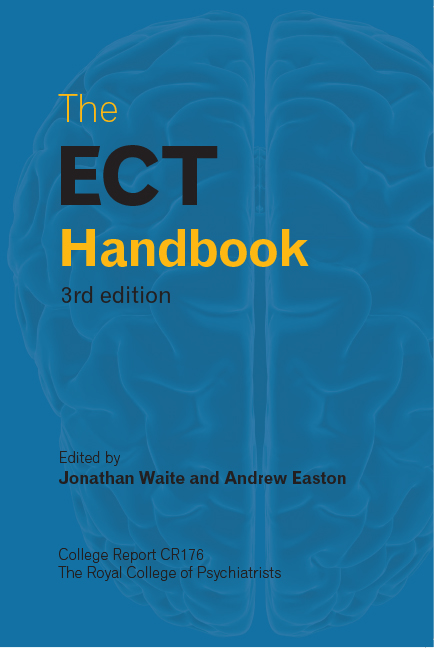Book contents
- Frontmatter
- Contents
- Abbreviations
- List of figures, tables and boxes
- List of contributors
- Preface
- Introduction: the role of ECT in contemporary psychiatry: Royal College of Psychiatrists’ Special Committee on ECT and Related Treatments
- 1 Mechanism of action of ECT
- 2 The ECT suite
- 3 Anaesthesia for ECT
- 4 ECT prescribing and practice
- 5 Psychotropic drug treatment during and after ECT
- 6 Monitoring a course of ECT
- 7 Non-cognitive adverse effects of ECT
- 8 Cognitive adverse effects of ECT
- 9 Dental issues related to ECT
- 10 Training, supervision and professional development: achieving competency
- 11 Nursing guidelines for ECT
- 12 Inspection of ECT clinics
- 13 Other brain stimulation treatments
- 14 The use of ECT in the treatment of depression
- 15 The use of ECT in the treatment of mania
- 16 The use of ECT in the treatment of schizophrenia and catatonia
- 17 The use of ECT in neuropsychiatric disorders
- 18 The use of ECT in people with intellectual disability
- 19 Safe ECT practice in people with a physical illness
- 20 ECT for older adults
- 21 The use of ECT as continuation or maintenance treatment
- 22 Consent, capacity and the law
- 23 Patients’ and carers’ perspectives on ECT
- Appendix I Out-patient declaration form
- Appendix II ECT competencies for doctors
- Appendix III Example of a job description for an ECT nurse specialist
- Appendix IV Example of a job description for an ECT nurse/ECT coordinator
- Appendix V Information for patients and carers
- Appendix VI Example of a consent form
- Appendix VII Useful contacts
- Appendix VIII Example of a certificate of incapacity
- Index
14 - The use of ECT in the treatment of depression
- Frontmatter
- Contents
- Abbreviations
- List of figures, tables and boxes
- List of contributors
- Preface
- Introduction: the role of ECT in contemporary psychiatry: Royal College of Psychiatrists’ Special Committee on ECT and Related Treatments
- 1 Mechanism of action of ECT
- 2 The ECT suite
- 3 Anaesthesia for ECT
- 4 ECT prescribing and practice
- 5 Psychotropic drug treatment during and after ECT
- 6 Monitoring a course of ECT
- 7 Non-cognitive adverse effects of ECT
- 8 Cognitive adverse effects of ECT
- 9 Dental issues related to ECT
- 10 Training, supervision and professional development: achieving competency
- 11 Nursing guidelines for ECT
- 12 Inspection of ECT clinics
- 13 Other brain stimulation treatments
- 14 The use of ECT in the treatment of depression
- 15 The use of ECT in the treatment of mania
- 16 The use of ECT in the treatment of schizophrenia and catatonia
- 17 The use of ECT in neuropsychiatric disorders
- 18 The use of ECT in people with intellectual disability
- 19 Safe ECT practice in people with a physical illness
- 20 ECT for older adults
- 21 The use of ECT as continuation or maintenance treatment
- 22 Consent, capacity and the law
- 23 Patients’ and carers’ perspectives on ECT
- Appendix I Out-patient declaration form
- Appendix II ECT competencies for doctors
- Appendix III Example of a job description for an ECT nurse specialist
- Appendix IV Example of a job description for an ECT nurse/ECT coordinator
- Appendix V Information for patients and carers
- Appendix VI Example of a consent form
- Appendix VII Useful contacts
- Appendix VIII Example of a certificate of incapacity
- Index
Summary
Depression remains the most frequent disorder for which ECT is required. This chapter summarises the evidence for the efficacy of ECT in depression and practical guidelines for its use. The Department of Health commissioned a systematic review of the safety and efficacy of ECT in depression (UK ECT Review Group, 2003), and for the NICE guidance on depression in adults, a further systematic review was undertaken (National Collaborating Centre for Mental Health, 2010: pp. 509–528.)
Efficacy of ECT in depression
The UK ECT Review Group (2003) examined data from randomised controlled trials identified in an extensive search. The results were independently checked by two reviewers. Data from studies which met inclusion criteria were extracted by paired members of the review team. Identified trials were assessed for methodology, where appropriate and data from individual trials were summarised by meta-analyses.
ECT v. ‘sham’ ECT
Six randomised controlled trials comparing ECT with ‘sham’ ECT in the short-term treatment of depression were examined by the UK ECT Review Group (2003). They included data on a total of 256 patients (Wilson et al, 1963; Lambourn & Gill, 1978; Freeman et al, 1978; Johnstone et al, 1980; West, 1981; Gregory et al, 1985). Most participants were in-patients under the age of 70 with some form of depressive disorder. The depression ratings at the end of treatment showed the standardised effect size (SES) between real and simulated ECT to be –0.91 (95% CI –1.27 to –0.54), indicating a mean difference in the Hamilton Rating Scale for Depression (HRSD) of 9.67 (95% CI 5.72 to 13.53) in favour of ECT. There have been no trials comparing ECT with sham ECT since the last edition of the Handbook.
ECT v. Pharmacotherapy
In 18 randomised controlled trials with a total of 1144 patients, ECT was compared with antidepressant medication in the short-term treatment of depression. Of these, 13 trials contained sufficient data to contribute to a pooled analysis. The SES of these trials was –0.80 (95% CI –1.29 to –0.29). This equates to a mean difference of 5.2 (95% CI 1.37 to 8.87) on the HRSD in favour of ECT. None of these trials compared ECT with newer antidepressant medications such as SSRIs, mirtazepine or venlafaxine.
- Type
- Chapter
- Information
- The ECT Handbook , pp. 126 - 134Publisher: Royal College of PsychiatristsFirst published in: 2017



